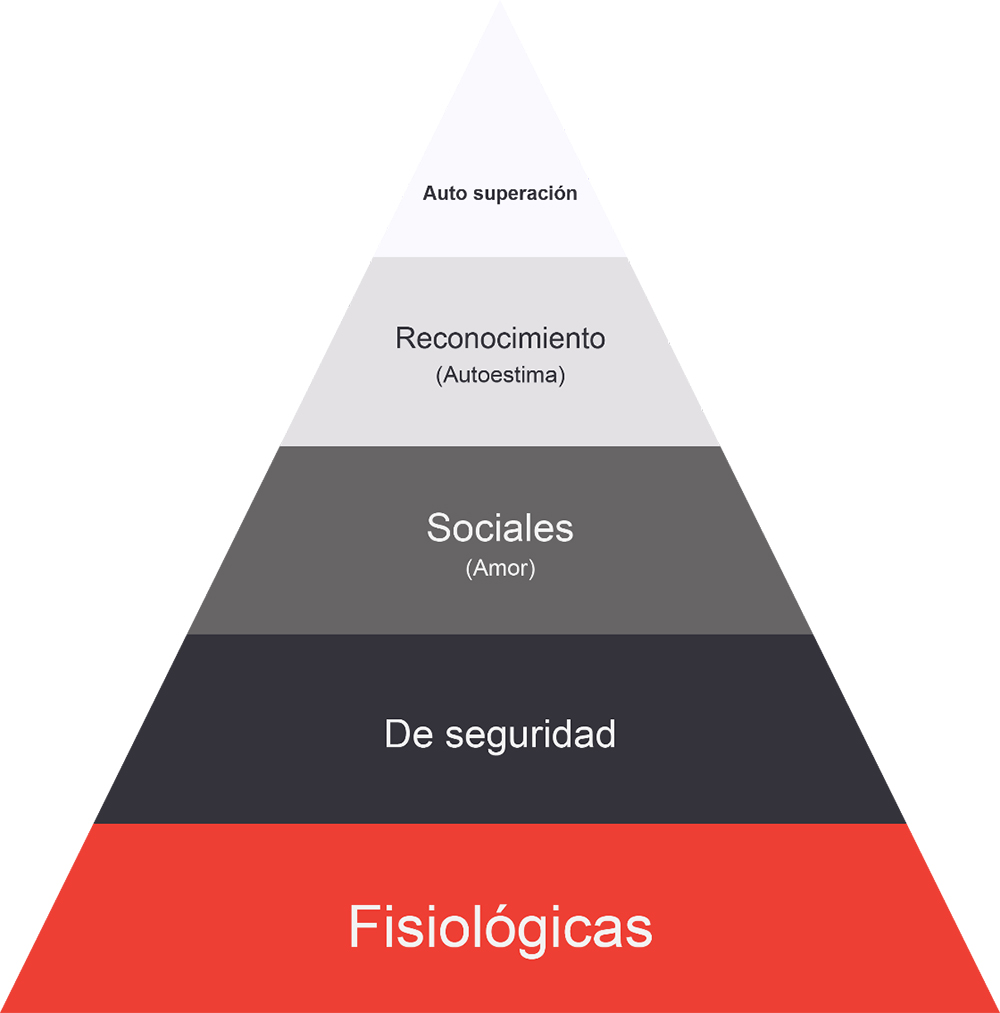
What is Maslow’s Pyramid?
Psychologist Abraham Maslow developed a theory (also known as the theory of human needs) about human well-being based on a hierarchy that classifies human needs according to their “relevance” or function, placing physiological needs (related to survival) at the base and “self-realisation ” needs (involving more creative and intellectual aspects) at the top.
Maslow argued that satisfying basic survival needs is a prerequisite for addressing higher needs. As we ascend the hierarchy, we face greater challenges to meet those needs due to intra or interpersonal and environmental obstacles that can generate frustration and other emotions.
Higher needs become increasingly psychological and long-term compared to lower needs, which are solely focused on survival and, therefore, more physiological and short-term.
What does it consist of?
It consists of five steps, each becoming more challenging to attain:
- Physiological needs encompass essential biological requirements for human survival, such as breathing, eating, drinking, clothing…. Physical survival constitutes our most fundamental need, becoming the primary driver of our behavior. Once we satisfy this level, motivation toward the next emerges, and so on. From Maslow’s perspective, these needs hold the utmost importance, as he believed that all other needs take a back seat until their satisfaction is achieved. For example, who thinks about going to a museum when they haven’t eaten for two days?
- Safety needs: People yearn to experience order, a sense of certainty, and control in their lives. These needs can be met through structures like family and society, which include institutions like the police, schools, businesses, and healthcare services. This encompasses aspects like emotional security, economic stability (such as employment and social assistance), maintaining order and law, absence of fears, social stability, etc.
Once physiological and safety needs are addressed, the third level of human needs emerges, which is social, involving the pursuit of connections and belonging.
- Love and belonging needs: These needs focus on the human emotional need to establish interpersonal relationships, seek affiliation, connection, and belonging to a group. Examples of these needs include friendship, intimacy, trust, acceptance, expression and reception of affection, love… This need is particularly intense during childhood and can even override the need for safety. This level relates to concepts like “attachment” and can significantly determine how we experience relationships as adults.
In the next level, social needs also arise, but they are related to self-concept.
- Esteem needs include components such as self-esteem, self-actualization, and respect (both self-respect and from others). Maslow divided these needs into two categories: (i) self-esteem, covering aspects like dignity, achievement, and independence, and (ii) the desire for reputation or respect from others, such as status and prestige. The pursuit of esteem reflects the common human desire to be accepted and valued by others. People often engage in professions or hobbies to gain recognition, providing a sense of contribution to society or value. A low level of self-esteem or an inferiority complex may arise as a consequence of imbalances in this level of the hierarchy. Maslow noted that the need for respect or reputation is particularly crucial for children and adolescents, preceding true self-esteem or dignity.
Moreover, this level can also be imbalanced and lead to certain narcissistic behaviors and obsessions with power.
- Finally, self-realisation needs are the highest level of Maslow’s hierarchy, referring to the realization of a person’s potential, self-actualization, the pursuit of personal growth, and “peak experiences,” as Maslow himself defined them.
This need level is related to the full potential of a person and the achievement of that potential. Maslow describes this level as the desire to achieve everything one can and “become everything one is capable of being.” The interpretation of this need can vary significantly among individuals. For example, for some, it may manifest as a strong desire to be an ideal parent; for others, it may express itself in the athletic or artistic realm, becoming a great doctor, etc.
Although Maslow did not believe that true self-realisation was attainable for many of us, he did argue that we all experience transient moments, known as “peak experiences,” of self-realisation. These moments, linked to personally significant events such as the birth of a child or a professional achievement, are difficult to achieve and maintain consistently.
What is the purpose of Maslow’s motivational pyramid?
Maslow’s pyramid can be used to analyze different aspects of our lives and plan what we can improve. A good exercise is to think about the moments when we have felt those “peak experiences” to try to attain them more frequently.
It can also be applied in the workplace, exploring where employees are on the pyramid and working with them on what they would need to move up a level.
A concrete example could be:
- Satisfaction of basic needs (steps 1 and 2): Providing fair wages and basic benefits such as health insurance and job security helps satisfy physiological and safety needs.
- Recognition and belonging (steps 3 and 4): The existence of a positive organizational culture fosters a collaborative and friendly work environment that can help meet social and belonging needs, making one feel valued. This increases motivation and performance while decreasing the likelihood of leaving the job. For example: team-building group dynamics, managers acknowledging work closely by congratulating or providing incentives, among other things.
- Self-realisation (step 5): As much as possible, providing opportunities for development and professional growth. Examples could include participation in challenging projects, promotion within the company hierarchy, allowing employees to make decisions and have a certain degree of autonomy in their roles to foster intrinsic motivation, among other strategies.
Understanding Maslow’s pyramid in the business environment helps leaders and managers design strategies that address employees’ diverse needs, thus creating a more motivating and satisfying work environment. However, it’s important to note that individuals’ motivation can vary, and not all employees will follow the same hierarchy of needs in a linear fashion.
Finally, we invite you to contact us to explore and better understand the aspects related to the different needs mentioned earlier. Understanding them can be beneficial for improving satisfaction and motivation in your workplace but also for other aspects of your life.
References
Maslow, A. H. (1991). Motivation and Personality. Ediciones Díaz de Santos.
Maslow, A. H. (2013). Toward a Psychology of Being. Simon and Schuster.
Xavi Ponseti
Col. Nº B-03138








